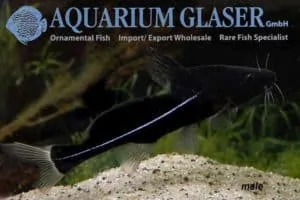Aplocheilus panchax
The body of Aplocheilus panchax is elongated and torpedo-shaped. Ground color highly dependent on the various find areas. Males: pale yellow, back darker, belly yellowish; in striking light with blue iridescent overtone. Especially on the upper body part a nice net marking due to the more or less dark rimmed scales. The dorsal fin is bluish with a large black spot on the base and a dark margin. Caudal fin powerful white laced, midfield yellowish, beautiful animals show a black rim of the tail fin at a younger age. The anal fin is orange at the base, otherwise reddish with dark dot markings. The females: not as brightly coloured; dorsal and anal fin rounded.
Due to the large distribution area and the somewhat variable colour, this species has often been re-described. The species has a very long list of names that have become synonynyms. See the Extra Information tab above this text.
Origin
Andaman Islands, Cambodia, India, India, Indonesia, Malaysia, Nepal, Pakistan, Myanmar, Bangladesh, Singapore, Sri Lanka, Thailand, and Vietnam.
Aplocheilus panchax lives there in shallow, still and slow-moving waters with dense vegetation of grasses and riparian crops.
Care
Aplocheilus panchax is suitable for large aquariums and can only be kept together with larger fish, with dense vegetation here and there and sufficient floating plants on the surface. Preferably dark. Whimsical driftwood parts are excellent as decoration material. Populate the upper and middle water layers. As well as related species predatory. Few requirements are set for the water quality. Temperature 22-24 degrees Celsius. Best kept as a pair or one male with several females. In fact, only live food animals are considered as food, but dry food is also taken for variety.
Breeding Aplocheilus panchax
Breeding the Aplocheilus panchax is not difficult. They also reproduce in community aquariums, but in order to achieve this, the temperature must be increased to approximately 25 degrees Celsius. The firm egg shell makes it possible to remove the eggs from the plants and transfer them to breeding shells. The young hatch after approx. 12-14 days and are easy to rear with the usual rearing foods.
For productive breeding, it is best to transfer the fish to breeding trays with a capacity of 10 litres.
Particularities
Many colour varieties of this species have been bred in captivity.
Video
Author
Bianca
Copyright images








Reviews
There are no reviews yet.